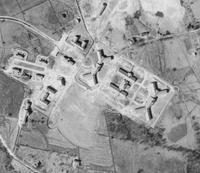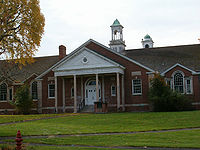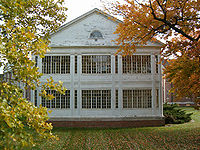Fairfield State Hospital
| Fairfield State Hospital | |
|---|---|
 | |
| Established | June 18, 1929 |
| Construction Began | Sept. 3, 1930 |
| Opened | July 5, 1933 |
| Closed | December 8, 1995 |
| Current Status | Preserved |
| Building Style | Cottage Plan |
| Architect(s) | Walter P. Crabtree, Sr |
| Location | Newtown, CT |
| Peak Patient Population | 2650 in 1949 |
| Alternate Names |
|
Fairfield State Hospital was created due to overcrowding at the other two state hospitals. The over all campus building style was Colonial Revival that was typical throughout New England. The hospital was designed not to have any dark corners or cubbyholes. A dedication ceremony was held June 10, 1931.. Roughly half of the main buildings were erected in the 1930s and '40s, with the rest of the larger ones completed in the 1950s.
Contents
[hide]History of the Hospital[edit]
Fairfield State Hospital, the third public mental institution to be established in Connecticut, had a stormy history from its inception. Members of the community actively resisted its location in the vicinity of Newtown and, for more than a decade, their attitudes had a negative Impact on its development. Dr. Leak, its first superintendent, although on the staff of Connecticut State Hospital for more than fifteen years and its superintendent for more than ten years, did not apply the knowledge gained through these personal experiences. Apparently neither he nor the Board of Trustees of Fairfield State Hospital recognized the importance of capitalizing on the developments that had taken place since the turn of the century at Connecticut State Hospital and Norwich State Hospital. From the beginning the Board expressed the attitude that this state facility for the men- tally ill would surpass its predecessors in the care and cure of those unfortunate People whose minds have become deranged with strange fancies and who have lost control over their thoughts and emotions.
This attitude contributed to the lack of communication between Fairfield State Hospital and the two other hospitals and perpetuated its isolation for more than twenty years. The associated drive for autonomy was reflected in the overt resistance to being integrated into the Department of Mental Health. This opposition was expressed by both the Board and the Superintendent during the fifties and sixties. Consequently advanced psychiatric concepts, practices and principles in nursing advocated by the Chief, Nursing Services were not accepted and implemented as readily in Fairfield Hills Hospital as in its sister hospitals.
Although the hospital was opened in the early thirties to relieve the overcrowding of both Connecticut State and Norwich State Hospitals, this objective was not achieved until the advent of the Unit System. Before 1964 the three State Hospitals were overcrowded and filled beyond their authorized capacities. With the implementation of the Unit System at Connecticut Valley and Norwich Hospitals in the mid sixties their respective patient populations were significantly decreased. Fairfield Hills Hospital remained over its capacity until it was decentralized into the Geographic U nit System in 1970. This hospital received its first patients on June 21, 1933 from Connecticut State Hospital. These patients were from Fairfield and Litchfield Counties and were selected by Dr. leak. with the thought of providing a nucleus for the essential working service of the institution...stress had been placed on maintaining a high percentage of employed patients not only for utilitarian purposes but for therapy as well.
By June 30, 1934, 536 patients had been received at intervals from Connecticut and Norwich State Hospitals. As at that time there were only two buildings, Shelton and Greenwich Houses, equipped to receive patients; the total capacity of the hospital was 500. With discharges, transfers and deaths, by the end of the first fiscal year, the census was reduced to 495. To care for this number of patients there were four physicians, including the superintendent, and fifty-eight psychiatric attendants. At that time the two nurses were also called psychiatric attendants and received the same salary. There were seventy-six other employees making a total of 136 in the Hospital.
In 1936 Fairfield State Hospital received 366 transfers from the other two hospitals, seventeen patients were discharged, and ten died. The average daily census was 507. The number of physicians remained four. There was an increase of ten in nursing service making a total of sixty- eight and the overall number of employees was 159. By June 30, 1940 there was a decline in the number of transfers, only fifty-three patients were received from the two other hospitals; the average daily census was 930. The number of physicians had increased to six. There were eighty-two attendants, and ten graduate nurses counting the director of nursing service and assistant director in nursing education. Also there were two occupational therapists, one social worker, and one dentist on the staff. Other employees totaled 102, thus bringing the number of employees to 204.
During the years 1940 and 1941 Kent and Canaan Houses were completed and for the first time patients were admitted directly from the community. However, transfers from Connecticut and Norwich State Hospitals continued. During the fiscal year ending June 30, 1941 there were 103 discharges and 86 deaths. The average daily census was 1,361. The staff included six physicians, twenty-one graduate nurses and 206 attendants, two occupational therapists and one social worker. The total number of hospital employees was 389. During the next eight years, the number of admissions increased significantly. This was primarily due to the direct admission of patients from the areas served by the hospital. However, transfers continued to be accepted from Connecticut and Norwich State Hospitals. During this period admissions averaged 797 patients each year. The average daily patient census increased steadily from 2,026 in 1942 to 2,692 in 1949, an increase of almost 28 per cent.
In the 1940s the turnover in ward personnel at times was over 50 per cent. In 1942, fifty-two employees were hired for nursing service and sixty-two, resigned. The high attrition rate was reflected in all departments of the hospital. During the fiscal year of 1946, 406 people were recruited to fill empty positions and 311 personnel had terminated. As of June 30, 1948, there were twenty-four graduate nurses and 203 psychiatric aides. In February 1949 the total number of hospital personnel had reached an all time high of 518; 255 of this number were in nursing service.
For the first time during the year ending June 30, 1951, admissions exceeded 1,000 and gradually increased to 1,715 by June 30, 1959. The discharge rate during this period increased from 680 to 1,228; the number of deaths fluctuated between 294 and 427 with a yearly average of 346. The average daily census ranged from 2,697 in 1957 to 2,871 in 1959. Nursing personnel also increased during this decade; graduate nurses, from twenty-five to sixty-five and psychiatric aides, from 222 to 506, an increase of more than 131 per cent. There was also an increase in personnel in other departments by the end of the fifties; physicians numbered seventeen, social workers, six and five case workers, four occupational therapists plus twenty-two students, and three psychologists.
From June 1960 to June 30, 1972 the annual number of admissions increased from 1,993 to 4,663; discharges, from 1,780 to 5,120; deaths ranged from a high of 482 in 1960 to a low of 158 on June 30, 1970 with the annual average of 325. The average daily census decreased from 2,723 to 1,496. For the first time since the establishment of the hospital, the number of patients discharged, 3,636, during the fiscal year ending June 30, 1966 exceeded the number of admissions, 3,443, by more than 5 per cent. During the next three years, the number of admissions exceeded the discharges by about 4 per cent. The trend was again re- versed in 1970 with the decentralization of the hospital; the discharges exceeded the admissions by 2.5 per cent during the fiscal year ending June 30, 1970; by 3.68 per cent during the next year, and by almost 9 per cent during the year ending June 30, 1972.
During the sixties the number of registered nurses employed fluctuated between fifty-one and sixty-two; the number steadily increased thereafter and by June 30, 1972, seventy-four full time and twenty-seven part time nurses were on the staff. During this same period the number of psychiatric aides also fluctuated with a yearly average of 511. By June 30, 1972, the number of psychiatric aides had decreased to 442, or by almost 18 per cent. The number of physicians increased from twenty-two in 1960, to a high of forty-one in 1968, then decreased to twenty- nine in 1970 and on June 30, 1972 increased again to thirty-five. (Physicians enrolled in the psychiatric residency training program were counted as medical staff.)
During this period from 1960 to 1972 the other departments within the hospital showed a slow but steady increase. The number of psychologists increased from four, in 1960; to six, in 1968 and 1970; and to seven, in 1972. The number of occupational therapists increased from six, in 1960; to ten, in 1968 and to fifteen, in 1970; thereafter, the number remained the same through the 1972 fiscal year. The social service department increased from four, in 1960; to eight, in 1968; and to twelve, in 1970. During the 1972 fiscal year there were twenty-five social workers in the department.
It is interesting to note that during the period extending from 1939 through 1950 the affiliating nursing students were listed as nursing personnel. Students were used as regular staff and classes were arranged during the afternoons after the ward work had been completed. They also worked the evening and night shifts. During this period the needs of nursing service took precedence over the learning needs of the students. The first group to affiliate included ten nursing students. Thereafter the number gradually increased so that by 1952 there were from sixty to sixty-five students in each group. Until 1953 there were no changes in this program. Students were taken off night duty but continued to be assigned to the evening shift until 9:00 P .M .The two nursing schools associated with the Fanny Allen and Mary Fletcher Hospitals in Vermont terminated their affiliation in September 1957; thereafter, the number of students in each affiliation group ranged from forty-five to fifty-five. In the later part of the 1960s, Danbury Hospital discontinued its School of Nursing. The Norwalk Hospital and Waterbury Hospital Schools of Nursing terminated their affiliation at Fairfield Hills Hospital in order to participate in an eight-week program at another psychiatric facility. In 1970 St. Mary's Hospital School of Nursing employed a psychiatric nurse clinical instructor to teach psychiatric nursing to their students but continued to use the clinical resources of Fairfield Hills Hospital. During the early seventies the number of students in each affiliation ranged from fifteen to thirty. Two nurse clinical instructors and the Director of Nursing Education were responsible for the instruction, guidance and supervision of the nursing students. Beginning in 1958 with the initiation of the educational work- shops, radical changes were made in the theoretical and clinical experiences provided for nursing students. The theoretical program changed from the didactic formal lectures, primarily given by the physician, to informal discussions with emphasis on group process and group dynamics under the leadership of the nurse instructor; the clinical experience, from frequent rotations to an assignment on the same ward for the duration of the affiliation. Also there was a gradual change in the nature of their assignments: not until the early sixties were they permitted to interact with individual and groups of patients. Thereafter the development of interpersonal relationships became the core of the program and the learning needs of the students took precedence over service needs.
For the-thirty-nine years of the existence of the hospital the Nursing Department was plagued by a large turnover and shortage of personnel. The nursing care was primarily custodial and members of the staff were given little recognition. In the late 1950s and early 1960s, some of the nursing personnel made attempts to change the ward environment and to organize and participate in therapeutic programs with their patients. They were influenced by the nursing students who were, under supervision, developing interpersonal relationships with selected patients and later, by the psychiatric aide trainees. These attempts were 'short-lived' as rotation to different wards and shifts were frequently made. This caused the staff to feel frustrated and discouraged. In 1970, with the implementation of the unit system and the establishment of the multidisciplinary teams, the roles and functions of the nursing personnel began to change and they began to gain recognition from other departments. These changes caused considerable anxiety. In an effort to utilize this anxiety constructively and to provide learning experiences that would develop their potentialities and prepare them to function more therapeutically, educational programs were implemented. However, as demands were constantly being made on the ward personnel to attend group and staff meetings, it became impossible to continue these programs. Later the Staff Development Program, funded by federal monies, made a real contribution and the nursing staff became more comfortable and efficient in carrying out their expanded functions and roles as members of the multi- disciplinary team.
Until 1970 the other clinical departments functioned independently. There was very little communication with other staff of the hospital, and it was only through the 'grape vine' that one heard what they were doing. The only thing all departments had in common was shortage of personnel. With the implementation of the Unit System and the team approach for planning and administering treatment programs, each department emerged to discover the meaning of working with members of other disciplines to improve the quality of treatment so that patients could be re- habilitated and returned to the community.
Future plans for other changes are now being made. Members of each Department are included in formulating these plans and are becoming more aware of the need for improving communication and relation- ships between departments as well as with the community. It is hoped that all of this will help to further improve and extend the psychiatric treatment programs for all patients whether in the hospital or in the community. [1]
Closure, Demolition, & Reuse[edit]
Due to deinstitutionalization in the '60s and '70s, there was less of a need for hospitals like Fairfield Hills. With the high cost of running underused hospitals, state hospitals around the country shut their doors. In 1995, Gov. John Rowland closed Fairfield Hills and its sister hospital, Norwich State Hospital. All patients that remained were moved to Connecticut Valley Hospital in Middletown, Connecticut. The Town of Newtown rented out the first floor of Canaan House from the mid-1990s up until 2005; it was home to the town's Board of Education, Planning & Zoning, and Fire Marshall. The Reed Intermediate School is also located on the property.
On June 7, 2001, the voters at a Town Meeting approved the purchase of the former Fairfield Hills Hospital from the State of Connecticut. A major portion of the land on the 185-acre Fairfield Hills campus has been reserved for municipal and cultural use, as well as passive and active recreational use. The campus is open daily for the public to enjoy during daylight hours. Hiking trails are available for public use and the various playing fields are managed by the Newtown Parks and Recreation Department.
A comprehensive reuse vision for the property is presented in the Fairfield Hills Master Plan. A select number of existing buildings and land parcels have been designated for private commercial purposes. A number of commercial uses including retail, offices, restaurants, banks, sports, cultural activities and business services will provide the community with a vibrant multipurpose campus.
On November 1, 2008 the Newtown Youth Academy celebrated it's grand opening. The new building sits at the rear of the property and occupies the land where the Bridgewater House once stood.[2] The Greenwich House, located just in front of the new Youth Center was demolished in 2009 to make room for a parking lot.[3]
On November 21, 2009 the Newtown Municipal Center At Fairfield Hills was dedicated. Formerly known as Bridgeport Hall, the building once served as the central dining facility at Fairfield Hills. The building has been refitted for use as the town's municipal office building. The expansive red brick structure had been in service for several weeks prior to the dedication as offices, the building has brought together most town agencies under one roof.[4]
Additional news about the ongoing renovation work can be found at the Fairfield Hills Campus Website
Images of Fairfield State Hospital[edit]
Main Image Gallery: Fairfield State Hospital
Video[edit]
1954 training film for psychiatric aides, filmed at Fairfield State Hospital
Links[edit]
References[edit]
- Jump up ↑ Carini, Esta, Dorothy M. Douglas, Lois D. Heck, Marguerite Pearson, The Mentally Ill in Connecticut: Changing Patterns of Care and the Evolution of Psychiatric Nursing 1636-1972, 1972.
- Jump up ↑ http://www.newtownbee.com/News/2008-11-06__12-33-27/Youth+Academy+Celebrates+Its+Grand+Opening
- Jump up ↑ http://www.newtownbee.com/News/2009-08-06__11-49-39/A+New+View+Emerges+After+Building+Demolition
- Jump up ↑ http://newtownbee.com/News/2009-12-01__16-12-13/Town+Dedicates+Newtown+Municipal+Center+At+Fairfield+Hills








